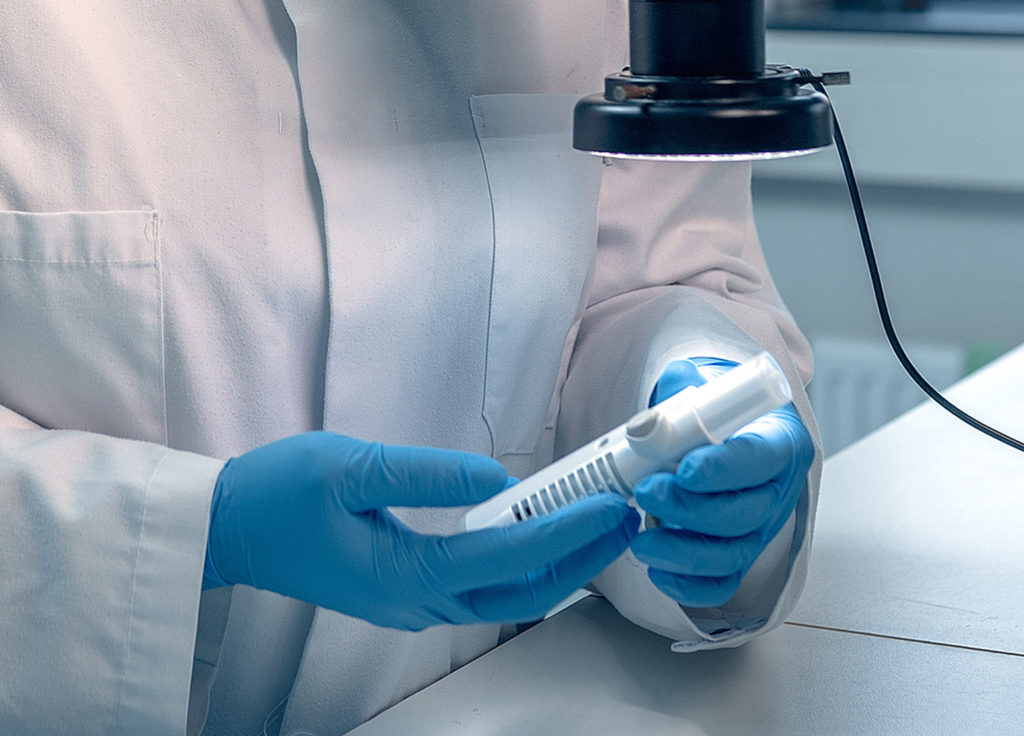To Issue 139
Citation: Hirst P, “Why Partnerships are Key to a More Sustainable Pharma Industry”. ONdrugDelivery, Issue 139 (Oct/Nov 2022), pp 56–58.
Peter Hirst argues that careful selection of partners and better collaboration throughout the supply chain are key to optimising the sustainability of the pharmaceutical industry. He explores the challenges facing the creation of sustainable drug delivery devices and discusses the measures that suppliers to the industry are taking to support customers in achieving their sustainability goals.
“Implementing sustainability measures directly contributes to ensuring that future generations can expect to live a long and
healthy life.”
Given the consequences of failing to act on climate change, governments worldwide are collaborating to enact legislation designed to reduce emissions of carbon dioxide and other industrial pollutants with a high global warming potential (GWP). For example, the Paris Agreement on climate change, adopted by 196 countries at COP 21 on December 12, 2015, commits signatories to take steps to limit global warming to below 1.5°C.
The pharmaceutical industry has an important part to play in achieving this goal. Increasingly, companies in the sector are looking to optimise sustainability, not simply to ensure compliance with government environmental legislation, but to play their own role in tackling global warming. However, the most fundamental action must come from all stakeholders in the pharmaceutical supply chain acting together to achieve a common goal.
LONG-TERM THINKING
Ultimately, the role of the pharmaceutical industry is to drive medical progress through novel research, and to develop and bring to market new medicines that improve the health and quality of life of patients. As such, the goal of minimising the sector’s impact on the environment is a logical one – an improved environment has significant benefits for people’s health and wellbeing. Implementing sustainability measures directly contributes to ensuring that future generations can expect to live a long and healthy life.
It is no surprise that the environmental impact of products and services now far higher up the list of priorities for pharmaceutical companies when engaging with suppliers. It is, in many cases, non-negotiable that each company has an effective plan to reduce carbon output and a sustainability strategy. A Global Data poll conducted in January 2021 found that 43% of pharmaceutical company respondents considered environmental issues a priority for the industry. Within this, 52% noted that the most pressing issue was climate change.1
The responsibility to act rests with every stakeholder in the supply chain – from the manufacturers of the drugs themselves to the contract development and manufacturing organisations (CDMOs) that aid in bringing the drugs to market, along with every other step in between. When selecting a CDMO, pharmaceutical companies are increasingly using sustainability measures as critical selection parameters. Typically, these are based on the capability of the supplier to deliver solutions that will reduce the overall carbon footprint of their products.
LEARNING FROM THE PAST
History holds many lessons for pharmaceutical companies when taking action to reduce their environmental footprint. One such lesson is the transition away from the use of chlorofluorocarbons (CFCs) as propellants in inhalation drug delivery devices towards the use of hydrofluoroalkanes (HFAs) following the signing of the UN Montreal Protocol in 1987. CFCs were found to be highly damaging to the ozone layer, contributing to its depletion, so steps were taken to phase out their use, not just within the pharmaceutical industry, but across all economic sectors.
Now, the industry faces another shift as, subsequently, HFAs have been found to be a major contributor to global warming. Research by the University of Cambridge (UK) found that pressurised dose inhalers (pMDIs) using HFAs could contribute to an estimated 3.9% of the carbon footprint of the National Health Service in the UK.2 GSK has calculated that 28% of its entire carbon footprint derives from patient use of its inhalers.3 As a result, the industry is looking for alternatives to HFAs, which means engaging in discussions with vendors regarding alternative, greener forms of propellant.
An alternative avenue could be to switch patients to dry powder inhalers (DPIs) or reusable soft mist inhalers (Figure 1) that do not use propellants. However, traditional DPIs use substantial amounts of plastic as part of their design, compared with pMDIs. Steps can be taken to redesign these devices to reduce the amount of material required, or to change to more sustainable bioplastics. The development of bioplastics has become a burgeoning industry with a strong market need, especially in the healthcare industry. As such, sourcing sufficient quantities of suitable medical-grade bioplastics may also present a challenge that will need to be overcome to ensure successful commercialisation

Figure 1: Soft mist inhaler.
IMPROVING EFFICIENCY
One of the most impactful ways in which pharma companies can build a more sustainable future for the industry is to improve efficiency through every stage of the drug development and manufacturing process. Alongside this, a greater emphasis on the recyclability of devices delivered to the end user is also crucial. This is especially the case for pMDIs, which often end up in landfill, leading to pollution from both plastic waste and their propellants being released into the atmosphere (Figure 2).4

Figure 2: pMDI valves and actuators.
“The process of improving the sustainability of drug delivery products, and across the industry more broadly, is an ongoing one that will take time and persistence.”
For drug device design, a trend that will have a significant impact on the viability of sustainability efforts is the movement towards connected devices.5 The existing problems the industry faces when drug delivery devices are thrown away are only magnified when the added components of connectivity technology are factored in, such as the inclusion of precious metals. Connected devices can play an invaluable role in disease management, ensuring patient adherence to their medication, but they need to be developed alongside a partner that is aware of the associated sustainability challenges to minimise their environmental impact.
CDMOs have a significant role to play in reducing the carbon footprint of a product. They must support pharmaceutical companies during the development and manufacturing process to ensure that production processes are as energy efficient as possible and that waste reduction is considered a priority. The good news on this front is that the rise of digital technologies is providing greater means of ensuring efficiency, such as the rise in the use of digital twin technology. Such technology is able to identify process improvements, with Accenture (Dublin, Ireland) recently reporting that it is possible to reduce process time, reduce cost of goods and lower greenhouse gas emissions significantly when employing digital twins.6
REGULATORY BACKING
To facilitate the work taking place to improve sustainability, the backing of regulators will be necessary, and those working in the industry must be ready to engage proactively in relevant discussions. For its part, the industry has already come together to create the Biopharma Investor ESG Communications Guidance 2.0,7 which was developed to generate dialogue between companies and investors to communicate best practice on climate change and environmental issues, as well as other social and governance issues. Other projects have been initiated, such as the Science Based Targets initiative, which Recipharm is part of, where companies commit to taking the necessary steps to reduce their carbon footprint.
However, when drug device developers address questions over sustainability in design, action can be limited by the need to submit the new design to regulators. As each change to a medical device design needs to be assessed by the regulator, this means innovation in more sustainable design can take years. One move that could encourage faster adoption of sustainable design would be for an accelerated approval process for changes to components that are designed to reduce the carbon footprint. Overall, the regulators can play an important role in dictating the direction of travel on the issue by taking action to facilitate and encourage sustainability improvements across the industry.
WORKING TOGETHER
There is a shift across the pharmaceutical industry, and discussions about sustainability are taking place at the highest levels. A growing number of pharmaceutical companies are prioritising it when discussing projects with their CDMO partners. In the coming years, it will be essential for drug developers and their CDMO partners to work together on questions of sustainability, and to be ready with a sustainability agenda prior to beginning work developing a new product and delivery device. Discussions do not end at the primary source of a product’s carbon footprint. As we begin to find solutions in this area, such as with alternative propellants or forms of delivery, work needs to be carried out simultaneously to understand the next largest contributor and potential remedies. The process of improving the sustainability of drug delivery products, and across the industry more broadly, is an ongoing one that will take time and persistence.
At each stage of the drug development process there are steps that need to be taken, which is why open communication between pharmaceutical stakeholders about sustainability is so crucial. This extends to working alongside competitors, which is necessary because of the scale of the problem that climate change poses to everyone. Even healthcare providers have a responsibility to communicate with drug developers to give feedback on how the device is used and disposed of to better understand its environmental impact in the real world. Designing a drug delivery device that marks an improvement on what came before takes time and adds cost, which ultimately means that payers will have to consider paying more for a greener product.
There are good reasons to believe that such discussions between all stakeholders can be productive because everyone is on the same page. The overall aim of the pharmaceutical industry is to achieve the international community’s target of net zero by 2050, and there are several companies working within the industry that have set themselves far more ambitious targets than this. With everyone understanding the importance of the challenge facing the world, the issues outlined in designing sustainable products can be overcome, but it will take a united effort across the pharmaceutical supply chain.
REFERENCES
- “Addressing ESG issues may help pharma to repair its reputation”. Globaldata.com, Feb 24, 2021.
- “Switching to ‘green’ inhalers could reduce carbon emissions and cut costs, study suggests”. University of Cambridge, October 30, 2019.
- “Understanding our 2017 value chain carbon footprint”. GSK report, 2020.
- “The environmental impact of inhalers”. North and East Devon Formulary and Referral, Mar 7, 2022.
- “10 Internet of Things (IOT) Healthcare Examples, and Why Their Security Matters”. Ordr, accessed September 2022.
- “Designing Disruption The critical role of virtual twins in accelerating sustainability”. Accenture report, 2021.
- “Biopharma Investor ESG Communications Guidance 2.0”. biopharmasustainability.com, Apr 2020.

